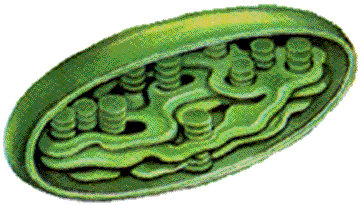- Photosynthesis takes place in chloroplast

- Green parts of plants carry out photosynthesis
- Chloroplasts are concentrated in the cells of the mesophyll
- The mesophyll is the inner layer of tissue
- Tiny pores called stomata are found on surface of leave
- Carbon dioxide enters and oxygen exits through stomata
- Veins carry water and nutrients from roots to leaves
- Also deliver organic molecules from leaves to other parts
- Chloroplast has inner and outer membrane
- Inner membrane encloses thick fluid called stroma
- Stroma has disk-shaped sacs called thylakoids
- Thylakods organize chemical reactions of photosynthesis
- In photosynthesis, electrons boosted "uphill" by light energy
- Excited electrons plus carbon dioxide and hydrogen ions produce sugar molecules

- 6CO2 + 6H2O --> C6H12O6 + 6O2 = equation for photosynthesis
- Two main stages: light reactions and the Calvin cycle
- Light reactions convert sunlight energy to chemical energy
- Reactions depend on molecules built into thylakoid membranes
- Chlorophyll captures light energy
- Chloroplasts use energy to remove electrons from water
- Splits water into oxygen and hydrogen ions
- Oxygen is "waste product"
- Electrons + hydrogen ions = NADPH
- Light energy also generates ATP
- Overall result: NADPH and ATP
- Calvin cycle makes sugar from atoms in CO2, hydrogen ions, and high-energy electrons carried by NADPH
- Enzymes for Calvin cycle located outside thylakoids and dissolved in stroma
- ATP provides energy to make sugar
- Calvin cycle does not directly require light
- Requires two inputs from light reactions: ATP and NADPH
Vocabulary
Chloroplast: organelle found in plant cells where photosynthesis takes place
Chlorophyll: pigment that makes chloroplast green; uses light energy to split water molecules during photosynthesis
Stroma: thick fluid contained in inner membrane of a chloroplast
Thylakoid: disk-shaped sac in the stroma of a chloroplast; site of light reactions of photosynthesis
Light reactions: chemical reactions that convert sun's energy to chemical energy; take place in the membranes of thylakoids in the chloroplast
Calvin cycle: cycle in plants that makes sugar from carbon dioxide, H+ ions, and high-energy electrons carried by NADPH
Concept Check 8.1
1) Draw and label a simple diagram of a chloroplast that includes the following structures: outer and inner membranes, stroma, thylakoids.
2) What are the reactants for photosynthesis? What are the products?
The reactants for photosynthesis are light energy, carbon dioxide, and water while the products are glucose and oxygen.
3) Name the two main stages of photosynthesis. How are the two stages related?
The two main stages of photosynthesis are the light reactions and the Calvin cycle. The light reactions convert light energy to chemical energy in the form of NADPH and ATP. The Calvin cycle then takes that energy to create sugar.


No comments:
Post a Comment